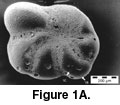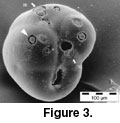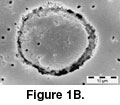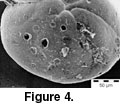 |

|

|
Ichnogenus FOSSICHNUS igen. nov.
Type Ichnospecies. Fossichnus solus igen et isp. nov.
Derivation of Name. "Foss-" (Latin fossa), meaning ditch, trench and channel, referring to the concavity of the trace fossil. "-ichnus" (Greek ikhnos), refers to trace.
Diagnosis. Biogenic concavity characterized by a circular to oval groove. Outer border conforms with inner border, both sharp in outline. Parts of the groove may penetrate through the substrate. Situated in skeletal substrates.
Fossichnus solus isp. nov.
Figure 1, Figure
2, Figure 3
1993 boring; Shroba,
(1993: 7h) illustrated an unnamed boring similar to F. solus
Derivation of Name. "solus" (Latin), alone, refers to the presence of only one groove.
 Holotype.
MGUH 26767 (Figure 1B), a specimen in the test of a benthic foraminiferan
(sample E10, Table 1).
Holotype.
MGUH 26767 (Figure 1B), a specimen in the test of a benthic foraminiferan
(sample E10, Table 1).
Type Locality and Age. 68║ N 55║ W, 190-200 m water depth: Quaternary.
Paratypes. MGUH 26768 (Figure 1C), situated in the same test as the holotype. MGUH 26769 (Figure 3A), in the test of a benthic foraminiferan (sample E10, Table 1).
 Diagnosis.
As for the ichnogenus, by monotypy.
Diagnosis.
As for the ichnogenus, by monotypy.
Description. Depth of the groove may vary in the same specimen. Where the groove penetrates the test its sides are parallel and perpendicular to the test surface. Substrate circumscribed by the groove may correspond in level with that immediately outside the groove. In some cases, however, the circumscribed substrate surface has been diminished by partial etching. Margin of the groove has a granular texture. The external diameter of the bioerosion structure ranges from 13 to 30 Ám, while the internal diameter ranges from 10 to 17 Ám. Width of the groove is max. 4 Ám. Multiple specimens of this trace fossil may occur in the same chamber of a foraminiferan. In such cases the trace fossils are apparently randomly distributed, but in some cases the density of the trace fossil is greatest in the adult chamber.
Remarks. Two kinds of problems arise with the ichnotaxonomic description of Fossichnus solus. Firstly, F. solus seems to be part of a developmental sequence, where the end member is Oichnus simplex (Figure 2). This interpretation is supported by the two overlapping F. solus shown in the aboral end of the test in Figure 3. Just above the aperture, in the same figure, an overlapping F. solus and an O. simplex are shown. It seems likely that the O. simplex started out as F. solus and later became O. simplex when the central field fell out. Whether this is a consequence of a physical process or whether F. solus should be considered an unfinished O. simplex is not known in all cases. As can be seen in the figures of F. solus, these structures partly penetrate the foraminiferal tests in many cases, which suggests that the transformation is part of a biological process. We cannot exclude that some of the observed O. simplex are not related to this biological process but the small size variation of the diameter between O. simplex and F. solus observed on the same test suggests these O. simplex are former F. solus. In this particular case, a re-definition of O. simplex will not solve the problem but would create taxonomic confusion. However, it makes little sense to consider two bioerosion structures belonging to the same sequence of formation as two different ichnospecies. The guidelines of the International Code of Zoological Nomenclature contain no solution to the taxonomic problem regarding such sequences. But in our case, there are strong indications, viz. size, shape and position on foraminiferal test, suggesting that some O. simplex are former F. solus.
 Secondly, does Fossichnus solus
represent part of a more complex structure? Most observations of F. solus
indicate that it is a random, repeated, solitary bioerosion structure. However,
in the example shown in Figure 4, eight F. solus are arranged in a
circular pattern around a main hole, which is slightly larger. Unlike many of
the other F. solus observed, this pattern cannot be considered a random
distribution. This distribution suggests that all of the bioerosion traces occurring on this
test are part of a single event, in which case they should be considered one
trace. If morphological features of the trace are to be the main taxonomic
criterion in ichnotaxonomy then it should be named differently from F. solus.
Secondly, does Fossichnus solus
represent part of a more complex structure? Most observations of F. solus
indicate that it is a random, repeated, solitary bioerosion structure. However,
in the example shown in Figure 4, eight F. solus are arranged in a
circular pattern around a main hole, which is slightly larger. Unlike many of
the other F. solus observed, this pattern cannot be considered a random
distribution. This distribution suggests that all of the bioerosion traces occurring on this
test are part of a single event, in which case they should be considered one
trace. If morphological features of the trace are to be the main taxonomic
criterion in ichnotaxonomy then it should be named differently from F. solus.
In contrast to Fossichnus, the ichnogenus Centrichnus includes individual bioerosion structures characterized by multiple grooves. Fossichnus solus differs from Centrichnus concentricus Bromley and Martinell, 1991, as the latter has a central rounded pit surrounded by a flat shelf. Furthermore, this shelf may be patterned with concentric rings. In contrast to F. solus, C. eccentricus Bromley and Martinell, 1991 is a tear- or drop-shaped scar, which comprises a series of bow-shaped grooves (Bromley and Martinell 1991,). Oichnus excavatus was defined by Donovan and Jagt (2002) as a circular to elliptical pit with a broad, high, raised central boss. As the aperture of O. excavatus is overhanging and the walls are concave, O. excavatus clearly differs from Fossichnus solus in morphology.
Fossichnus solus occurs abundantly in samples from Rhodes (samples P 56 and 194) and Greenland (samples E 2a, 5, 7, 9 and 10). Shroba (1993) illustrated an unnamed boring similar to F. solus. The boring was derived from temperate waters off Juan Island, Washington.
It is well known that gastropods of the family Cassidae and other predatory prosobranch families may prey on sea urchins (e.g., Hughes and Hughes 1971; Taylor et al. 1980; Hughes 1986; Lowry and Stoddart 1989). Cassid gastropods may form bioerosion structures that in an unfinished stage are similar to F. solus. For example, Cassis tuberosa feeds on regular echinoids by cutting a disc from their test. The resulting hole, which is formed by completing a roughly circular groove, is subcircular and has a rough edge (Hughes and Hughes 1971). The cassid Galeodea echinophora may prey on the infaunal spatangoid Echinocardium cordatum. This gastropod also cuts a disc out of the test, which it either pushes inward or displaces to one side (Hughes 1986). The holes, which show signs of acid etching, are indistinguishable from those made by C. tuberosa. Unfinished holes still holding a disc bear a close resemblance to Fossichnus solus isp. nov. However, their size is much larger than those observed in the foraminiferal tests.
Stratigraphic Range. Quaternary.
Sieve-shaped boring
Figure 5, Figure
6
Description. The bioerosion structure is a pit having a circular outline and penetrated by two or more holes or pits, evenly distributed within the pit. Diameter and depth of the pit are 18 Ám and 3 Ám, respectively. The pit is perforated by minor structures. As we have chosen not to examine the internal surface of the substrate of the unique specimen, it is unknown whether the structures are indeed holes penetrating through the test. These holes are less than 1 Ám in diameter. Each has a simple cylindrical form, oriented perpendicular to the surface of the major pit. The major pit has a granular appearance, because the holes are closely situated.
Remarks. The boring is characterized by a sieve-shaped texture. The substrate, i.e., the foraminiferal test, is assigned to Quinqueloculina of the family Miliolida. As specimens of Miliolida are non-laminar and imperforate (Haynes 1981; Hansen 1994), the sieve-shaped texture cannot be related to microstructural characteristics of the test.
The major pit of the sieve-shaped boring is similar to O. paraboloides Bromley, 1981 (see Nielsen and Nielsen 2001). But, the sieve-shaped boring consists of both a pit and tiny holes and clearly differs from previously known bioerosion structures. As the sieve-shaped boring has only been observed in a single benthic foraminiferan collected from Rhodes (sample P 194), it is left in open nomenclature.
Stratigraphic Range. Pleistocene.
Ichnogenus OICHNUS
Type Ichnospecies. Oichnus simplex Bromley, 1981, by original designation.
Emended diagnosis. Circular, subcircular, oval or rhomboidal solitary holes or pits of biogenic origin in hard substrates, commonly perpendicular to subperpendicular to substrate surface. The holes pass directly through substrate as a penetration, whereas the pits end within the substrate as a shallow to moderately deep depression or short subcylindrical pit, commonly with a depth:width ratio of 1, with or without a central boss (emended after Bromley 1981; Nielsen and Nielsen 2001; Donovan and Jagt 2002; Donovan and Pickerill 2002).
Remarks. The original diagnosis was emended by Nielsen and Nielsen (2001) to include a greater variety of holes and pits and to cover the morphology of Tremichnus Brett, 1985, which they considered a junior synonym of Oichnus. Subsequently, a further emendation was provided by Donovan and Jagt (2002) in order to accommodate their O. excavatus. The above emended diagnosis is that of Donovan and Pickerill (2002) but excluding the word "excavation" (suggesting soft substrate). The word "solitary" has been added to emphasize the difference between Oichnus and Dipatulichnus Nielsen and Nielsen, 2001. The latter is characterized by holes in pairs.
Oichnus aff. O. asperus
Figure 7, Figure
8
Description. The structure is characterized by a crescent-shaped outline and occurs in a foraminiferal test. The external opening is equal to or slightly larger than the internal opening. Both openings are sharp in outline. Largest dimension, measured on the external opening, is 56 Ám. Its smallest dimension is 24 Ám. Margin of the hole is perpendicular to external test surface or converging slightly inward in a straight manner. The margin has a granular texture.
Remarks. The margin shows an etched relief, which probably was produced by the tracemaker. The substrate bears no other signs of etching. Only a single Oichnus aff. O. asperus has been observed in a benthic foraminiferan, collected at Rhodes (sample P 135).
Oichnus aff. asperus differs from known ichnospecies of Oichnus in its elongated and curved outline. The former bears closest resemblance with O. asperus Nielsen and Nielsen (2001), which is regular to irregular elongate-oval in outline. None of the specimens studied by Nielsen and Nielsen (2001) was curved. The boring thus is left in open nomenclature, following the nomenclatural guidelines by Bengtson (1988).
Stratigraphic Range. Pleistocene.
Oichnus aff. O. paraboloides
Figure 9, Figure
10
Description. Oichnus aff. O. paraboloides situated in skeletal substrate is characterized by a straight elongated groove with a sharp outline. A circular hole is situated within the groove close to one end. A distinctive feature is the elongate outline of the groove. Its length, width and depth are at their maximum 147, 47 and 38 Ám, respectively. Bottom of the groove is even in level, although the substrate surface immediately outside the groove varies in level. The groove is parabolic in cross-section. Where the groove penetrates the foraminiferal test its sides are oblique or perpendicular to the test surface. Margin of the groove has a smooth texture. The transition from the groove to the inner opening is gradual and smooth. Diameter of the hole is 33 Ám.
Remarks. The studied samples contain no similar structures. No evidence indicates that Oichnus aff. O. paraboloides could be an artifact related to sample collection and preparation. Thus, O. aff. paraboloides clearly is a biogenic structure. The smooth transition between the groove and the hole suggests that the trace fossil is not a composite structure, but that the same process formed the entire structure during one event. The shape and position of the hole probably have been influenced by the shape of the substrate. The only known specimen was obtained from sample P 53 collected at Rhodes.
The circular hole resembles ichnospecies of Oichnus; however, the groove is straight and elongate, which is not seen in any ichnospecies of Oichnus or other known trace fossils. Oichnus aff. O. paraboloides resembles O. paraboloides Bromley, 1981 that includes specimens of "Oichnus having a spherical paraboloid form, being truncated in those cases where the boring penetrates right through the substrate" (Bromley, 1981, p. 62). The former also resembles O. ovalis Bromley, 1993, which originally was characterized as an oval Oichnus tapering subparabolically from a larger external opening to a smaller inner one. The morphological variability of O. aff. paraboloides is unknown and may turn out to vary significantly, depending on the exterior and interior shape of the substrate. The boring thus is left in open nomenclature.
Stratigraphic Range. Pleistocene.